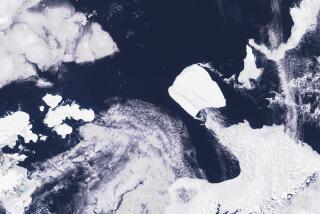SCIENCE FILE : Science in Brief : Antarctic’s Ozone Hole Expected to Be 20% Smaller
- Share via
The “ozone hole” over the Antarctic is expected to be about 20% smaller than it was last year because polar winds have eased, a U.N. expert said Wednesday. “Last year was the biggest and the strongest ozone depletion in Antarctica,” said World Meteorological Organization ozone expert Rumen Bojkov. “This year is not as strong as last year, but it is as strong as half of the years of the ‘90s.” The main cause of ozone depletion is chlorine and bromine released by man-made chemicals.
As in previous years, ozone depletion started in July and intensified during August, Bojkov said. The hole currently covers 3.09 million square miles, close to the size of Europe, and will probably grow to about twice that, he said. Normal fluctuations in the intensity of atmospheric winds contribute to the hole’s size, he added. Last year, the whirlpool-like winds that develop annually in the stratosphere above the South Pole were very strong.
Compiled by Times medical writer Thomas H. Maugh II






